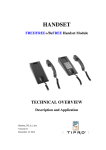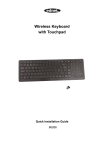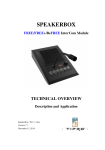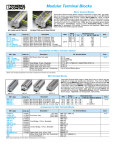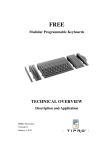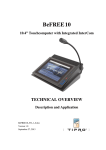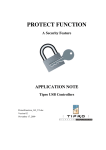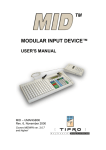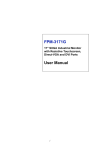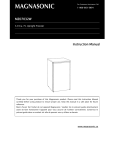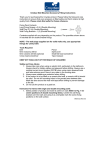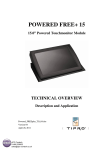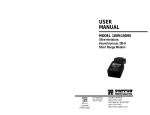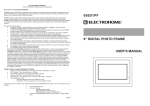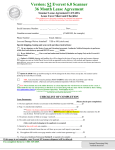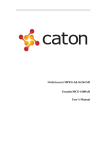Download HANDSET
Transcript
HANDSET FREE/FREE+/BeFREE Handset Module TECHNICAL OVERVIEW Description and Application Handset_TO_06.doc Version 06 May 30, 2012 TABLE OF CONTENTS II TABLE OF CONTENTS A. GENERAL INFORMATION.......................................................................................A-1 A.1. Highlights ..............................................................................................................A-1 A.2. Technical Characteristics ......................................................................................A-2 B. INTEGRAL PARTS AND FUNCTIONALITY .......................................................... B-1 B.1. Handset .................................................................................................................. B-2 B.2. Cradle (Base) ......................................................................................................... B-2 B.2.1. Microphone Amplifier ................................................................................... B-2 B.2.2. Loudspeaker Amplifier.................................................................................. B-2 B.2.3. USB Audio Codec ......................................................................................... B-2 B.2.4. USB Interface ................................................................................................ B-3 B.3. Differences between TM-HUA-5AW and TM-HUA-6AW ................................. B-3 B.4. Differences between TM-HUA-5AW and TM-HUM-5AW................................. B-4 B.5. USB Handset Module with Integrated Dial-Pad TM-HUx-5KW ................... B-4 B.6. Analogue Handset Module TM-HHA-6AW ......................................................... B-6 C. CONFIGURING THE MODULE ................................................................................ C-1 C.1. Detecting................................................................................................................ C-1 C.2. Setting Up.............................................................................................................. C-1 C.3. Programming ......................................................................................................... C-2 D. USING USB AUDIO....................................................................................................D-1 D.1. Installation.............................................................................................................D-1 D.2. Volume Setting......................................................................................................D-2 D.3. Side-Tone Feature .................................................................................................D-3 D.4. Using Tipro USB Audio Modules.........................................................................D-4 E. ORDERING CODES .................................................................................................... E-1 F. REFERENCES ...............................................................................................................F-1 G. NOTICES......................................................................................................................G-1 G.1. Disclaimer .............................................................................................................G-1 G.2. Copyright Notice ...................................................................................................G-1 HANDSET – TECHNICAL OVERVIEW A. GENERAL INFORMATION A-1 A. GENERAL INFORMATION The USB Handset module (TM-HUA-5AW) is a USB audio device for digital bidirectional voice communication. It is a FREE/ FREE+/ BeFREE add-on module to be combined with the other family members into a multifunctional terminal/console for various applications. Superseding its predecessor TM-HUA-6AW, it brings a number of new features, such as hardware-generated side-tone, adjustable microphone volume, logarithmic microphone amplifier with noise-gating function, acoustic shock protection and improved immunity to external electromagnetic fields (see Chapter B.3). PushToTalk/PustToMute key and Hook switch operate as programmable keys (i.e. emulating user definable input from a standard computer keyboard) what enables seamless integration of these features into an existing application software without an intervention in the code. Two RGB LEDs within the cradle visually indicate the status of the switches (Talk / Mute and On Hook / Off Hook). Once configured (see Chapter C), the module does not require any proprietary software to operate, but rather generic USB HID keyboard (for PTT key and Hook switch) and USB audio (for voice) drivers of the operating system in use. As all other FREE/ FREE+/ BeFREE add-on modules, the TM-HUA-5AW requires a Tipro controller to operate. The controller is normally integrated into another module (e.g. a touchcomputer, a touchmonitor or a keyboard module) within the same configuration. Alternatively, for a stand-alone application, a special variant of the module with integrated controller (TM-HUM-5AW) is also available (see Chapter B.4). Both variants of the handset (i.e. TM-HUA-5KW and TM-HUM-5KW) can optionally incorporate the Dial-Pad with 12 mechanical keys (see Chapter B.5) to provide for more ergonomic dialling. The keys are programmable in the same way as PTT key and Hook switch. A.1. Highlights APPLICATIONS ♦ dispatcher terminals ♦ banking & trading consoles ♦ multifunctional control panels ♦ digital telephony (e.g. Voice over IP) devices CONCEPT AND MODULARITY ♦ handset with integrated PushToTalk / Mute key and Hook switch HANDSET – TECHNICAL OVERVIEW A. GENERAL INFORMATION A-2 ♦ combination of a USB audio device and an HID keyboard ♦ plug & play operation with generic USB audio and USB HID keyboard drivers ♦ ♦ ♦ ♦ side-tone generated internally by the hardware software - adjustable volume (loudspeaker and microphone) and side-tone level integrated acoustic shock protection circuitry combinable with other FREE/FREE+/BeFREE add-on modules (e.g. touchcomputers, touchmonitors, Speakerbox, Chameleon, keypads, ID modules, …) into multifunctional terminals ♦ stand-alone operation as a FREE/FREE+/BeFREE module with integrated Tipro USB controller (TM-HUM-5AW) ♦ optional analogue interface (direct connection to the loudspeaker and the microphone) ♦ optional Dial-Pad in the cradle for ergonomic dialling PROGRAMMABILITY ♦ programmable PushToTalk/PushToMute key (also referred to as switch) ♦ programmable magnetic Hook switch (also referred to as key) ♦ two RGB LEDs indicating status (Talk / Mute and On Hook / Off Hook) various operating modes 5 different colours: Red / Green / Blue / Orange / Violet ♦ programmable Dial-Pad keys (TM-HUx-5KW only) A.2. Technical Characteristics ELECTRICAL ♦ power supply (audio circuitry): 5V ± 5% (from USB) ♦ power supply (control circuitry): 5V ± 5% (from Tipro controller via Tipro bus) ♦ current consumption (audio circuitry): 85 mATYP (100 mAMAX) ♦ current consumption (control circuitry): 35 mATYP (55 mAMAX) ♦ additional current consumption of TM-HUM-5xW: 25 mATYP (45 mAMAX) ♦ audio interface: USB (except for TM-HHA-6AW – see Chapter B.5) ♦ control interface: TIPRO bus ♦ control interface of TM-HUM-5xW: USB ♦ interface connectors: left-hand side Tipro bus connector: 6-pin Micro-MaTch header (male) at the end of a 100 mm long ribbon cable right-hand side Tipro bus connector: 6-pin Micro-MaTch receptacle (female) on the PCB HANDSET – TECHNICAL OVERVIEW A. GENERAL INFORMATION A-3 USB connector: USB type B Handset connector: RJ 6P/6C MECHANICAL ♦ casing: plastic ABS, black colour – C15 ♦ ♦ ♦ ♦ net dimensions: 70 x 222 x 66 (W/D/H) [mm] gross dimensions (with side-covers): 90 x 222 x 66 (W/D/H) [mm] weight: 400 g (approximately) protection (sealing) grade: IP 40 (according to EN 60529) ENVIRONMENTAL ♦ operating ambient temperature range: 0°C to +40°C ♦ storage ambient temperature range: -10° C to +50°C ♦ relative humidity range: 20% to 80% (non-condensing) AUDIO ♦ Analogue front-end designed to meet narrow-band telephony standards frequency pass-band: (200 Hz - 5 kHz) TYP ♦ USB Audio Codec model: Texas Instruments PCM 2912x USB Interface: full-speed, USB 2.0 compliant, certified by USB-IF resolution: 16-bit Delta-Sigma ADC and DAC sampling rates (ADC & DAC): 8, 11.025, 16, 22.05, 32, 44.1, 48 kHz MECHANICAL KEYS AND REED SWITCHES ♦ PTT/ PTM key (two keyswitches in parallel) model: Cherry ML key travel: 2.5mm to 3.0mm total actuating force: (45 ± 20) cN reliability (Mean Cycles To Failure): MCTF = 1 billion (109) press/release cycles (20 million is guaranteed minimum) ♦ Hook switch (reed switch) reliability (Mean Cycles To Failure): MCTF = 500 million (5x108) switching cycles (20 million is guaranteed minimum) HANDSET – TECHNICAL OVERVIEW A. GENERAL INFORMATION B-1 B. INTEGRAL PARTS AND FUNCTIONALITY Two major parts – a handset and a cradle – constitute the module. The handset is connected to the cradle by a handset cord. Loudspeaker Hook switch PushToTalk/Mute key Wall-mount "tooth" Microphone Tipro bus cable to be connected to adjacent FREE/FREE+/BeFREE module Connector plate Figure B.1 USB Handset Module – Integral Parts HANDSET – TECHNICAL OVERVIEW A. GENERAL INFORMATION B-2 B.1. Handset The handset itself is a combination of a dynamic loudspeaker, an electret microphone and a PushToTalk/Mute key. It is connected to the cradle by a spiral shielded cable that improves immunity to external electromagnetic fields. The cable (also referred to as handset cord) is detachable at the cradle side (see Figure B.2). B.2. Cradle (Base) The cradle contains an electronic board with a hook switch, analogue conditioning circuitry, a USB audio Codec, LED indicators and a microcontroller. The USB audio Codec converts analogue signals into a digital USB data stream and vice versa, while the microcontroller supervises the operation and enables modularity/ programmability via Tipro bus. The hook switch is a reed contact activated by a magnet inside the handset. B.2.1. Microphone Amplifier The microphone amplifier is a logarithmic audio amplifier with noise gating and compression features. Noise gate discards all sounds below the threshold, thus effectively suppressing ambient noise. The compression feature enables compression of the output signal dynamics in order to minimize the difference between quiet and loud speech. The amplifier is also capable of limiting extremely loud speech and therefore prevents distortion and popping. The output of the amplifier connects to the Analogue-to-Digital Converter (ADC) inside the USB Codec chip. B.2.2. Loudspeaker Amplifier The loudspeaker amplifier is a linear audio amplifier with differential output and limiting circuitry to prevent an acoustic shock. It drives the loudspeaker inside the handset with a signal which is a composition of the output signal (USB audio data stream received from the computer and converted by Digital-to-Analogue Converter inside the USB Codec chip) and a part of the microphone signal (so-called side-tone). The left and right channel of the Codec’s stereo output and internally summed prior to the amplification. B.2.3. USB Audio Codec The audio Codec with USB interface is the Texas Instruments’ PCM2912x integrated circuit (refer to respective data sheet for details). HANDSET – TECHNICAL OVERVIEW A. GENERAL INFORMATION B-3 B.2.4. USB Interface Audio interface of the module is full-speed USB, compliant to the USB 2.0 specification. It is accessible from the bottom of the cradle (see Figure B.2) at the USB upstream (type B) connector to be connected to a USB downstream port of the Tipro USB controller inside some other (a touchmonitor or a keyboard) module within the same FREE/FREE+/BeFREE configuration. Handset Connector RJ 6P/6C USB Connector Type B Figure B.2 USB Handset Module – External Connections In case of TM-HUM-5AW the USB is also the control interface and must be connected to a self-powered or a root hub, because the integrated Tipro USB controller itself comprises a bus-powered USB hub. B.3. Differences between TM-HUA-5AW and TM-HUA-6AW The TM-HUA-5AW is the successor and a superset of the TM-HUA-6AW. It provides several new functions and features: new USB Codec IC supporting all standard sampling rates, both for ADC and DAC ambient noise suppression (noise gating) compression and limiting microphone signal software - adjustable microphone volume hardware - generated side-tone software - adjustable side-tone level acoustic shock protection improved immunity to external electro-magnetic fields HANDSET – TECHNICAL OVERVIEW A. GENERAL INFORMATION B-4 Consequently, the migration should be beneficial and seamless. However, there is a potential compatibility issue. Since TM-HUA-5AW incorporates a different USB Codec IC, its USB Product ID is also different. Therefore if the actual application software reads the Product ID to identify the module (what is rarely the case), it will need to be modified to support the new one (see Chapter D.4). B.4. Differences between TM-HUA-5AW and TM-HUM-5AW The TM-HUM-5AW is a stand-alone version and a functional superset of the TMHUA-5AW module. It additionally incorporates a Tipro USB controller with built-in buspowered hub (one downstream port is occupied by the Tipro controller, another one with the USB Audio Codec). Other specific details (e.g. current consumption, interfacing …) are pointed out in respective chapters hereby. Figure B.3 Stand-Alone USB Handset Module (TM-HUM-5AW) B.5. USB Handset Module with Integrated Dial-Pad TM-HUx-5KW The USB handset, either as a module (TM-HUA-5KW) or the module with integrated Tipro USB controller (TM-HUM-5KW), can optionally incorporate the Dial-Pad with 12 mechanical keys to provide for more ergonomic dialling. The keys are programmable in the same way as PTT key and Hook switch. HANDSET – TECHNICAL OVERVIEW A. GENERAL INFORMATION Figure B.4 B-5 USB Handset Module with Integrated Dial-Pad (TM-HUx-5KW) MECHANICAL KEYS ♦ keyswitch model: Cherry ML key travel: 2.5mm to 3.0mm total actuating force: (45 ± 20) cN reliability (Mean Cycles To Failure): MCTF = 1 billion (109) press/release cycles (20 million is guaranteed minimum) ♦ keycaps construction: separate body and cover size: single keycap bodies: CN15 black colour key legends: printed on the keycap bodies keycap covers: transparent user-customizable key legends/pictograms (to be printed on a thin paper and put underneath the keycap covers) HANDSET – TECHNICAL OVERVIEW B. INTEGRAL PARTS AND FUNCTIONALITY B-6 B.6. Analogue Handset Module TM-HHA-6AW The TM-HHA-6AW is an analogue derivative of the handset module. It lacks audio processing circuitry (both analogue and digital), providing a direct connection to the loudspeaker and the microphone via RJ4P/4C jack/socket. The connector is placed in the cradle instead of the USB Type B connector (refer to Figure B.2). The handset cord is 6wire spiral unshielded cable. The external audio cable is a 4-wire unshielded straightthrough cable 2.5m long (TM-CH1). The loudspeaker is connected between pins 2 and 3, electrically “floating” (no ground connection). The microphone is also “floating” between pins 4 (positive) and 1 (negative). LOUDSPEAKER ♦ type: dynamic ♦ impedance: 150 Ω TYP @ 1 kHz @ 1 V ♦ output sound pressure level (SPL): 93dB ± 3 dB @ 1 kHz ♦ frequency range: (200 Hz - 4 kHz) TYP MICROPHONE ♦ type: electret condenser, omni-directional ♦ output impedance: 2.2 kΩ MAX ♦ sensitivity: - 36 dB ± 3 dB (0 dB = 1 V/ Pa @ 1 kHz) ♦ frequency range: (100 Hz - 5kHz) TYP All other (non-audio) functions are the same as of the TM-HUA-5AW. The module (TM-HHA-6AW) is intended for direct connection to the Speakerbox module (see Reference [1]) as well as to a third-party analogue audio processing hardware. HANDSET – TECHNICAL OVERVIEW C. CONFIGURING THE MODULE C-1 C. CONFIGURING THE MODULE The ChangeMe software is required only to configure the module (as normal operation requires only generic drivers of the operating system in use – see Chapter D). It is supplied free of charge and operates exclusively under Windows operating systems. The Hook switch and the PushToTalk / Mute key can be programmed to send a sequence of key codes, exactly as being entered by a standard keyboard. Respective LED indication can be configured as well. C.1. Detecting Connect a FREE/FREE+/BeFREE configuration comprising USB handset to a computer and run ChangeMe software. The actual configuration is automatically detected and displayed on the desktop. Click on the handset icon to open the settings. Handset Icon Figure C.1 Example Configuration – Touchmonitor and USB Handset C.2. Setting Up Content Indication Figure C.2 Handset Settings Dialog HANDSET – TECHNICAL OVERVIEW C. CONFIGURING THE MODULE C-2 On the right hand side set what content is to be sent to the computer when the PTT key is pressed and released, and when the handset is taken from the cradle (active line) and put back (waiting for call). On the left hand side select the colour of the LED indicators upon the respective action/event. In this example, when the handset is lifted up (Off Hook), the lower LED turns from blue to green. When the PTT key is pressed, the system receives the key F1 and the upper LED turns from green to red. OK saves the configuration and closes the dialog, Cancel just closes the dialog. C.3. Programming At the end of the process all parameters need to be programmed into the hardware for permanent storage. Programming Figure C.3 Programming the Contents HANDSET – TECHNICAL OVERVIEW D. USING USB AUDIO D-1 D. USING USB AUDIO The USB Handset module implements a standard USB audio Codec. Therefore no device specific driver is needed for the module to operate under Windows operating systems. However, it may or may not be the case with other operating systems, such as Linux, where it depends on the actual distribution, kernel version, etc. D.1. Installation After first connection to a computer, the operating system automatically detects a new hardware and installs the correct drivers. The audio interface of the handset is recognized as a USB Audio Device (see Figure D.1). Figure D.1 Device Manager The preferred audio device can be set in sound and multimedia properties. This (preferred audio device) is the audio device used by application software with the default audio settings (see Figure D.2). Normally, audio application software has its own settings to define specific audio device to be used. These settings can override Windows settings and therefore need to be adjusted accordingly. HANDSET – TECHNICAL OVERVIEW D. USING USB AUDIO Figure D.2 D-2 Sounds and Multimedia properties D.2. Volume Setting Both loudspeaker and microphone volume can be set with standard Microsoft mixer. Double click on the speaker tray icon brings up the USB Audio Device volume settings (see Figure D.3). Loudspeaker Volume Figure D.3 Speaker Settings The Microphone level can be adjusted by selecting Options → Properties and then the recording part of the mixer. The Microphone mixer will appear (see Figure D.4). HANDSET – TECHNICAL OVERVIEW D. USING USB AUDIO D-3 Microphone Volume Figure D.4 Microphone Settings D.3. Side-Tone Feature The USB Handset offers the side-tone feature integrated in its hardware. When enabled, a part of the microphone signal is being returned back to the loudspeaker thus providing an immediate acoustic feedback. This feature enables the user to hear own speech also in the ear being covered by the earpiece of the handset, what is especially important in noisy environments. Level of the side-tone can be set with the Microphone slider within the Speaker mixer. The feature can be enabled / disabled by checking the Mute checkbox (see Figure D.5). Side-Tone Level Side-Tone ON/OFF Figure D.5 Side-Tone Settings HANDSET – TECHNICAL OVERVIEW D. USING USB AUDIO D-4 D.4. Using Tipro USB Audio Modules Besides the USB Handset Tipro also offers other USB audio modules (e.g. Speakerbox, Touchmonitor with integrated loudspeakers) that can be joined into a single FREE/FREE+/BeFREE configuration. On the other side, Windows operating systems present each of them as a USB Audio Device. In order to enable independent addressing and differentiation, each type of FREE/FREE+/BeFREE audio module (Handset, Speakerbox, Touchmonitor) has a different USB product ID (see Chapter B.3). However, Tipro can not guarantee that the actual Product ID of the USB Handset module (or any other individual FREE/FREE+/BeFREE USB audio module) will not change in future, as it depends on the USB Codec IC vendor(s) who reserve the right to change it. HANDSET – TECHNICAL OVERVIEW E. ORDERING CODES E-1 E. ORDERING CODES 1 T M - 2 3 H U A - 4 5 6 5 A W - 7 C15C25 8 - xxx 1 – Module Type H – Handset module 2 – Audio Interface U : USB T : USB with HID Telephony Interface (only as a customization) 3 – Configuration A : Standard FREE/FREE+/BeFREE add-on module M : FREE/FREE+/BeFREE module with integrated Tipro USB controller 4 – Handset Cord 5 : 5-wire shielded cable 5 – PTT/PTM and Hook Operation A : Programmable keys K : Programmable keys (with integrated Dial-Pad) 6 – Position of the Wall-Mount “Tooth” W : sticking out (Wall-mount ready) - default none: hidden 7 – Housing Colour C15C25 – black (C15) with special protective finishing (C25) on the upper part of the handset housing 8 – Custom Version Three-digit number reserved for product customizations. It is omitted in case of standard version. Note 1: USB interface cable (TM-CU1) is included. Note 2: The upper part of the handset housing is protected with a special coating in order to improve its abrasion resistance. The coating modifies the shade of the original black (C15) colour, what is referred to as C25 colour. HANDSET – TECHNICAL OVERVIEW F. REFERENCES F-1 F. REFERENCES 1. “SPEAKERBOX” – Technical Overview 2. 3. 4. 5. “CHAMELEON” – Technical Overview “POWERED FREE+ 15” - Technical Overview “BeFREE” - Technical Overview “ChangeMe” – User’s Manual 6. 7. 8. 9. “Modularity Demystified” – “Dispatching Hints & Tips” White Paper – Issue No. 001 “2 Handsets in 1 Terminal” – “Dispatching Hints & Tips” White Paper – Issue No. 002 “3 Handsets in 1 Terminal” – “Dispatching Hints & Tips” White Paper – Issue No. 003 “HID Telephony Interface” – “Dispatching Hints & Tips” White Paper – Issue No. 005 HANDSET – TECHNICAL OVERVIEW G. NOTICES G-1 G. NOTICES G.1. Disclaimer Information furnished by Tipro is believed to be accurate and reliable. However, Tipro makes no representations or warranties regarding the accuracy or completeness of the contents of this document and reserves the right to make changes to specifications and product descriptions at any time without notice. G.2. Copyright Notice 2004-2012 Tipro. All rights reserved. Trademarks and registered trademarks are the property of their respective owners. HANDSET – TECHNICAL OVERVIEW




















